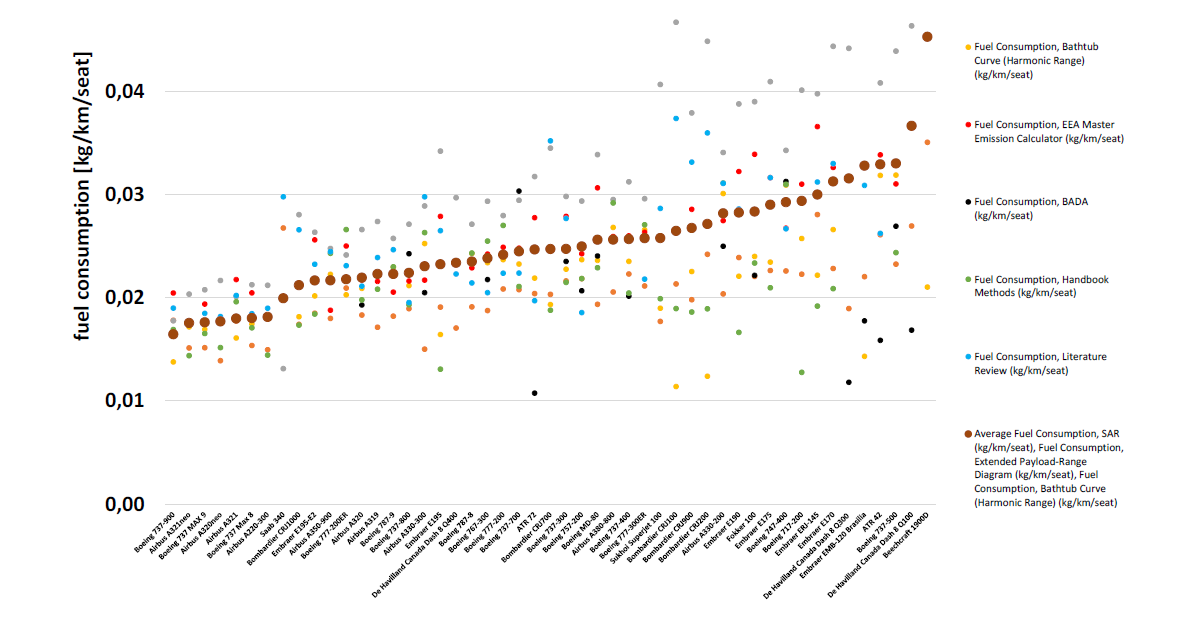
Fuel Consumption of the 50 Most Used Passenger Aircraft
Project
Autor: Marius Kühn
Date: 2023-09-11
Supervisor: Dieter Scholz
Abstract
Purpose - Fuel consumption of passenger aircraft is certainly known, but towards the public it is considered an industry secret. This project defines fuel consumption for passenger aircraft, shows and evaluates methods and databases for its calculation, and lists the fuel consumption of the 50 most-used passenger aircraft. Input data is only from publicly available documents. --- Methodology - 8 ways are considered to determine fuel consumption: Method 1: Specific Air Range (SAR), Method 2: Extended Payload-Range Diagram, Method 3: Bathtub Curve at Harmonic Range, Method 4: EEA Master Emission Calculator, Method 5: BADA, Method 6: Handbook Method, Method 7: Literature Review, Method 8: Metric Value (MV). Method 2 is the simplest method, calculating fuel consumption from the difference of maximum take-off mass (MTOM) and maximum zero-fuel mass (MZFM), which is divided by harmonic range and number of seats in the aircraft. Method 8 calculates fuel consumption from the CO2 Metric Value (MV) defined in ICAO Annex 16, Vol. 3 and EASA CS-CO2. --- Findings - Fuel consumption should be defined as kilogram of fuel per kilometer flown, per seat. Each aircraft type has many variants. Different sources give different values for the parameters. This can lead to undetected errors and deviations among the results from different methods beyond their fundamental differences. Method 1 underpredicts, Method 2 overpredicts. Method 4 is a reliable source with apparently good results, but new aircraft types (like A320neo) are presently not in the database. For Method 8, EASA so far publishes only MVs from flight tests with the A330neo. More data will come with new aircraft being certified. With 7 input parameters, an average value can be calculated from Methods 1, 2, and 3. The results give a good first indication of aircraft's fuel consumption. Fuel consumption depends on range. For an economic range (range at maximum payload, harmonic range) modern aircraft consume between 0.02 kg/km/seat and 0.025 kg/km/seat of kerosine. --- Research Limitations - The accuracy of the methods is limited. For this reason, the aircraft with the lowest fuel consumption cannot be named. CO2 emissions can be calculated directly from fuel consumption (3.15 kg CO2 / kg fuel). Otherwise, this project does not go further into emission calculations. --- Practical Implications - Simple methods to determine the fuel consumption of passenger aircraft are presented. --- Social Implications - Fuel consumption of passenger aircraft can be investigated and can be discussed openly independent of (missing) manufacturer's data. --- Originality - So far, no report discusses so many ways to determine fuel consumption of passenger aircraft in such a simple and practical way.
Download full text
 TextKuehn.pdf
Size: 2.8M
TextKuehn.pdf
Size: 2.8M
URN, the Persistent Identifier (from the German National Library) to quote this Landing Page:
https://nbn-resolving.org/urn:nbn:de:gbv:18302-aero2023-09-11.011 
Entries into
- the German National Library (https://www.dnb.de),
- the Repository of Leibniz University Hannover (https://www.repo.uni-hannover.de) for the DOI,
- and the Internet Archive
will come later.
Associated research data: https://doi.org/10.7910/DVN/4CYNKA
Download the poster
 AERO_POS_DLRK2023_AerospaceClassification_2023-09-19.pdf
AERO_POS_DLRK2023_AerospaceClassification_2023-09-19.pdf
Persistent Identifier:
https://doi.org/10.48441/4427.1045 (Landing Page)
https://purl.org/aero/POS2023-09-19b (PDF)

Passenger aircraft fuel consumption from various methods. Recommended is to take the average of the Methods 1, 2, 3.
Aircraft sorted by results from the Average Method. Method 1: Specific Air Range (SAR) (orange, low values); Method 2: Extended Payload-Range Diagram (gray, high values); Method 3: Bathtub Curve at Harmonic Range (yellow).
LAST UPDATE: 27 April 2024
AUTHOR: Prof. Dr. Scholz
IMPRESSUM (PDF)

 Prof. Dr. Scholz
Prof. Dr. Scholz
 Aircraft Design and Systems Group (AERO)
Aircraft Design and Systems Group (AERO)
 Aeronautical Engineering
Aeronautical Engineering
 Department of Automotive and Aeronautical Engineering
Department of Automotive and Aeronautical Engineering
 Faculty of Engineering and Computer Science
Faculty of Engineering and Computer Science
 Hamburg University of Applied Sciences
Hamburg University of Applied Sciences


 TextKuehn.pdf
Size: 2.8M
TextKuehn.pdf
Size: 2.8M

 AERO_POS_DLRK2023_AerospaceClassification_2023-09-19.pdf
AERO_POS_DLRK2023_AerospaceClassification_2023-09-19.pdf

 Prof. Dr. Scholz
Prof. Dr. Scholz
 Aircraft Design and Systems Group (AERO)
Aircraft Design and Systems Group (AERO)
 Aeronautical Engineering
Aeronautical Engineering
 Department of Automotive and Aeronautical Engineering
Department of Automotive and Aeronautical Engineering
 Faculty of Engineering and Computer Science
Faculty of Engineering and Computer Science
 Hamburg University of Applied Sciences
Hamburg University of Applied Sciences